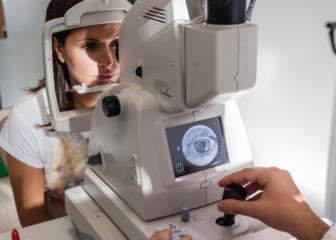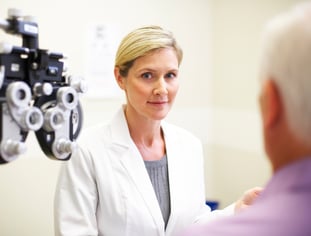Comprehending the Duty of Your Eye Doctor in Maintaining Vision
Comprehending the Duty of Your Eye Doctor in Maintaining Vision
Blog Article
Checking Out the current Technical Innovations in Optometry and What They Mean for Eye Doctors
In the ever-evolving area of optometry, recent technological advancements are reshaping how specialists come close to eye care. From the accuracy of Optical Coherence Tomography to the nuanced insights supplied by AI-driven diagnostic tools, these developments are establishing brand-new requirements in patient analysis and therapy. Teleoptometry is poised to redefine accessibility, guaranteeing that experience goes beyond geographical limitations. As these innovations penetrate the method, eye doctors are faced with the difficulty of embracing these tools to improve client end results. Yet, the concern continues to be: exactly how will these technological changes redefine the functions and obligations within the occupation?
Innovations in Diagnostic Equipment
Advancing the field of optometry, technologies in analysis devices have actually transformed the method eye treatment specialists analyze and diagnose visual problems and ocular problems. The previous decade has actually seen considerable technological improvements, enabling even more detailed and accurate analyses.
An additional trick innovation is the intro of innovative corneal topography systems, which map the surface curvature of the cornea with accuracy. These devices are specifically helpful for fitting get in touch with lenses and diagnosing corneal conditions. Additionally, digital retinal imaging has actually transformed standard ophthalmoscopy, offering detailed, breathtaking views of the retina that help with thorough aesthetic evaluations.
The development of wavefront aberrometry has actually also been essential, enabling the evaluation of refractive mistakes with unparalleled precision (Optometrist Chino). This technology helps in customizing rehabilitative lenses and enhancing surgical outcomes for refractive surgical treatments. Jointly, these diagnostic developments encourage eye doctors to deliver superior individual care, guaranteeing early treatment and tailored treatment methods, inevitably boosting aesthetic health and wellness end results
AI in Individual Management
Building on the foundation of innovative diagnostic devices, the unification of artificial knowledge (AI) in person monitoring represents a transformative jump for optometry. AI systems are significantly employed to improve efficiency, precision, and personalization in person treatment.
Moreover, AI-driven systems assist in streamlined client communications and management processes. Automated scheduling, digital examinations, and customized follow-up plans not only improve client satisfaction but additionally optimize time management for specialists. These systems can triage clients based upon the urgency of their problems, ensuring that those in critical need obtain prompt attention.
Furthermore, AI improves decision-making by supplying optometrists with evidence-based referrals and therapy paths. By integrating data from digital health documents, AI devices provide understandings that inform scientific choices, lowering the danger of errors and improving individual outcomes. As AI remains to evolve, its function in client management will likely broaden, reshaping the landscape of optometric treatment.
Advances in Retinal Imaging
In the world of optometry, retinal imaging has witnessed exceptional technical advancements that are enhancing analysis capabilities and individual treatment. Technologies such as Optical Coherence Tomography (OCT) and fundus photography have actually changed exactly how optometrists evaluate the retina and imagine.
Improved imaging techniques like OCT angiography are additional refining analysis accuracy. Optometrist Chino. Such advancements promote the recognition of minute retinal adjustments that could signify condition progression.
In addition, innovations in check my reference artificial knowledge are enhancing retinal imaging by making it possible for automatic evaluation of big datasets. These systems help optometrists in recognizing patterns indicative of pathology, consequently enhancing diagnostic accuracy and effectiveness. Jointly, these technologies are transforming retinal imaging into a keystone of modern eye treatment, enhancing outcomes and increasing healing opportunities.
Teleoptometry's Expanding Duty
Teleoptometry is significantly coming to be a vital element of eye treatment, driven by improvements in digital interaction and analysis devices. This is especially helpful in underserved and rural areas where accessibility to specialized eye treatment is often limited.
The assimilation of synthetic knowledge (AI) further boosts teleoptometry, enabling the analysis of visual information and helping in the discovery of ocular conditions such as glaucoma and diabetic person retinopathy. AI-powered formulas can rapidly interpret complex imaging information, providing optometrists with useful insights that strengthen professional decision-making.
In addition, teleoptometry sustains connection of treatment with seamless assimilation with digital health and wellness documents (EHRs), allowing eye doctors to preserve detailed client backgrounds. When consulting with different specialists., this guarantees that clients receive regular and individualized treatment even.
In spite of these advantages, challenges continue to be, consisting of ensuring information safety and security and handling client assumptions. Teleoptometry represents a significant stride in the direction of more available, effective, and patient-centered eye care. As modern technology evolves, its role is positioned to broaden better.

Future Patterns in Eye Treatment
A myriad of innovative trends is readied to reshape the future of eye treatment, driven by technical advancements and the advancing needs of people. One considerable trend is the integration of fabricated knowledge (AI) in diagnostics, which assures to YOURURL.com boost the accuracy and effectiveness of eye examinations. AI formulas can analyze large amounts of information from retinal images, possibly discovering problems like diabetic retinopathy and glaucoma earlier than conventional methods.
Moreover, customized medicine is gaining traction in optometry, with genetic testing educating tailored treatment strategies. This strategy aims to maximize patient results by tailoring interventions to individual hereditary profiles. Wearable innovation, such as wise call lenses, is additionally coming up, providing real-time monitoring of click over here now intraocular stress or glucose degrees, thus offering continuous understandings into eye and systemic wellness.
The fostering of enhanced reality (AR) and virtual fact (VIRTUAL REALITY) in training and person education and learning is another arising fad. These modern technologies provide immersive experiences that can improve understanding and skills both for people and eye doctors. As these patterns progress, optometrists should remain abreast of technical developments to provide cutting-edge treatment, making certain improved person results and fulfillment in the dynamic landscape of eye treatment.
Final Thought

Jointly, these analysis developments equip optometrists to supply remarkable patient care, making certain very early intervention and customized therapy techniques, eventually boosting aesthetic health and wellness outcomes.

As these modern technologies proceed to advance, optometrists need to adjust and include them into technique, inevitably enhancing workflow efficiency and boosting the criterion of eye treatment provided to individuals.
Report this page